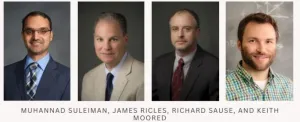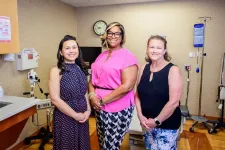(Press-News.org) In the past few years, we’ve seen a push toward renewable energy. One focus is wind, which is harvested via turbines–you may have seen them in mountainous areas, turning in the wind. But the United States’s most abundant wind potential lies offshore; wind speeds are highest off both coasts. This means offshore wind turbines promise high energy yields, akin to the offshore wind production in the North Sea near northern Europe.
But constructing wind turbine platforms in water deeper than ~60 meters presents problems. Turbines in shallow waters, like those in the North Sea, can be mounted on fixed-bottom platforms, held to the sea floor by a rigid structure such as a monopile or foundation. The offshore turbines now operating in the U.S. are fixed bottom turbines located in the relatively shallow waters over the Continental shelf near New England. But deeper water, like that along the northeast and the West Coast, which represents two-thirds of US offshore wind resources, renders this type of mount impractical. Engineers are therefore turning to floating offshore platforms and attempting to create economical, innovative floating structures that can harvest wind energy while also capturing energy from wave action.
Floating platforms, which originated with oil and gas drilling, are held in place by mooring lines anchored to the ocean floor in various designs and configurations. And unlike oil and gas platforms, they need to carry the taller, unbalanced load of a wind turbine. So floating wind platforms present their own set of problems, issues that Muhannad Suleiman and his co-investigators at Lehigh University–James Ricles, Richard Sause, and Keith Moored–are working to solve.
Suleiman, Professor of Civil and Environmental Engineering and Deputy Director of the Advanced Technology for Large Structural Systems (ATLSS) Center; Ricles, Bruce G. Johnson Professor of Structural Engineering and Director of the Advanced Technology for Large Structural Systems (ATLSS) Center; Sause, Joseph T. Stuart Professor of Structural Engineering; and Moored, Associate Professor of Mechanical Engineering and Mechanics, have recently received a $1 million National Science Foundation Research Advanced by Interdisciplinary Science and Engineering Clean Energy Technology (NSF RAISE CET) award for a three-year project called “Coupled Aero-Hydro-Geotechnical-Mechanical Interaction and Control of Floating Offshore Wind Turbines Subjected to Extreme Loading Conditions.”
Offshore wind platforms experience extreme forces from just about every direction. The winds that load the turbine can be quite strong, pushing both the turbine blades and the platform; the waves can also cause force against the platform and pull on the mooring lines, which in turn exert a pulling force against the anchors holding them in place. Extreme weather events, such as a hurricane or major storm, can exacerbate all these forces. Suleiman notes that such events “apply significant loads to the structure, including wind and wave loading on the structure.” Wind and waves are also sources of energy. The Lehigh team is trying to combine wind and wave energy generation to make these floating offshore platforms more efficient and resilient.
The efficiency and resilience goals will move in four steps. The first is finding new ways to reduce the platform’s motions. Pitch (up and down) and roll (side-to-side) motions are a focus here as they amplify the movements along the length of the turbine, from sea level to the rotor. Limiting these motions improves the resilience of the structure. This part of the research project will be led by Moored and Sause.
The second is evaluating effects of platform motion reductions on mooring line fatigue response; this part of the project will be led by Sause. After establishing a baseline for platform movement, innovations such as ballast placement and damper systems will be studied for their effects on the platform’s movement.
The third goal involves investigating bio-inspired concepts for energy generation and foundations to improve platform stability and to determine potential increased power output. Oscillating hydrofoils, kinetic devices attached beneath the platform, are modeled according to the movements of aquatic animals, who are masters at navigating unsteady and vortical flows. Bio-inspired anchors will also be analyzed; these rough-surfaced anchors–inspired by snakeskin–increase friction between the foundation and surrounding soil to resist pull-out forces. This facet of the research will be led by Suleiman and Moored.
The fourth goal involves real-time hybrid simulations and is led by Ricles. The data from the previous research tasks–the aero, hydro, geotechnical, and mechanical of the project title–will be used to simulate their combined interactions under extreme loading conditions, allowing the team to address the technical challenges and interactions involved in floating offshore wind energy production. The wind, water and mechanical loads on the turbine, platform, and mooring lines will be analyzed and combined with experimental results on the soil and the foundation to produce “the response of the whole floating offshore wind turbine system which help understand the interaction between different parts (or subsystems) interact,” Suleiman says. This is important, he says, because most of the time, these subsystems are treated separately: a structural engineer will look at the loads on the tower, a mechanical engineer will study the aero and hydrodynamic loads, and so on, but there are few ways to study the entire system as a single operating unit. Bringing all the parts together not only mimics the real interactions of these subsystems, but also allows for a greater understanding and the maximization of their operation and energy output.
The team will use Lehigh University facilities at ATLSS and Suleiman’s soil-foundation-structure interaction facility, as well as the real-time hybrid simulation facility.
END
Lehigh University researchers awarded $1 million NSF grant to investigate floating offshore wind turbines
CEE Professor Muhannad Suleiman leads interdisciplinary team that seeks to combine wind and wave energy generation to make floating offshore platforms more efficient and resilient
2024-07-22
ELSE PRESS RELEASES FROM THIS DATE:
SNIS 2024: New study reveals possible link between gastrointestinal syndromes and risk of brain aneurysm
2024-07-22
COLORADO SPRINGS, Colo. — There is a potential connection between a diagnosis of certain gastrointestinal (GI) syndromes and the formation and rupture of intracranial (brain) aneurysms, according to research presented today at the Society of NeuroInterventional Surgery’s (SNIS) 21st Annual Meeting.
An intracranial aneurysm (IA) occurs when a blood vessel in the brain bulges, putting pressure on the vessel wall. IAs that rupture cause brain bleeding and lead to a hemorrhagic stroke, a life-threatening emergency requiring immediate medical attention ...
More Black Americans die from effects of air pollution
2024-07-22
Everyone knows that air pollution is bad for health, but how bad depends a lot on who you are. People of different races and ethnicities, education levels, locations and socioeconomic situations tend to be exposed to different degrees of air pollution. Even at the same exposure levels, people’s ability to cope with its effects — by accessing timely health care, for example — varies.
A new study by Stanford Medicine researchers and collaborators, which takes into account both exposure to air pollution and susceptibility to its harms, found that Black Americans are significantly more likely to die from causes related to air pollution, compared ...
New study identifies two proteins that may contribute to stroke recurrence
2024-07-22
EMBARGOED UNTIL 2 p.m. Monday, July 22, 2024
Contact:
Jillian McKoy ,jpmckoy@bu.edu
Michael Saunders, msaunder@bu.edu
Jarka Meleszkiewicz, jarka.meleszkiewicz@bristol.ac.uk
##
New Study Identifies Two Proteins That May Contribute to Stroke Recurrence
The study discovered genetic markers in inflammation that may be related to a second stroke or other major cardiovascular event following a stroke. These findings could help identify drug targets to mitigate stroke-related disability and mortality.
People who experience an arterial ischemic stroke (AIS) or transient ischemic stroke (TIA) are at an increased risk of suffering a second stroke or other major adverse cardiovascular ...
Virtual reality training for physicians aims to heal disparities in Black maternal health care
2024-07-22
CHAMPAIGN, Ill. — During a checkup with her obstetrician, Marilyn Hayes tells him about overwhelming exhaustion and possible symptoms of postpartum depression, such as feeling unsafe. Hayes, a Black woman, grows increasingly frustrated as her white, male physician, Dr. Richard Flynn, dismisses her symptoms and ignores her wishes when she refuses medication. Hayes becomes visibly uncomfortable when Flynn touches her without permission and makes comments steeped in Black stereotypes, such as assuming that ...
Science, Social Studies classes can help young English-learning students learn to read and write in English
2024-07-22
A new study finds that science and social studies classes may also help young students learn English, even when those classes include difficult and technical vocabulary.
The study, which observed first- and second-grade students in 30 elementary schools in North Carolina, encouraged teachers to keep their English-learning students in class during science and social studies lessons. Science and social studies textbooks in those grades are often relatively technical and difficult for students, so traditional teaching methods in North Carolina encourage teachers to remove English-learning students from those content classes ...
Wijesekera receives funding for FHWA driving simulator support research: Hands-on support for CDA/CARMA - ARCHER Integration Phase I
2024-07-22
Duminda Wijesekera, Professor, Cybersecurity Engineering; Professor, Computer Science, received funding for the project: “FHWA Driving Simulator Support Research: Hands-on support for CDA/CARMA - ARCHER Integration Phase I.”
He will evaluate and test the Nvidia Drive Sim to understand functionality, behaviors, limitations, and interfaces that would be required in full integration.
Nvidia Drive Sim is a simulation platform for autonomous vehicles.
He will also work to discern the ...
Study: Retail viability in Fairfax City mixed use development
2024-07-22
Center for Retail Transformation (CRT) and Center for Real Estate Entrepreneurship (CREE) jointly received funding to study retail viability led by Mehmet Altug, Associate Professor, Information Systems and Operations Management and Director of CRT, Costello College of Business.
Led by Mehmet Altug, the two centers CRT and CREE at Costello College of Business have teamed up to determine market-specific retail opportunities within Fairfax City, specifically within five Small Area Plans. The project will specifically consider ...
Converting captured carbon to fuel: Study assesses what’s practical and what’s not
2024-07-22
The struggle to cut emissions is real.
Last year, the world emitted more than 37 billion metric tons of carbon dioxide, setting a new record high. As a result, sucking CO2 out of the atmosphere has become an increasingly popular idea. Governments worldwide are banking on this technology, called direct air capture, to help them achieve climate goals and avoid the worst consequences of climate change.
But despite more than a dozen direct air capture facilities being up and running around the globe already, the technology ...
University of Houston flexes scientific muscle with breakthrough in skeletal muscle regeneration
2024-07-22
Newly published research from the University of Houston College of Pharmacy identifies key mechanisms of skeletal muscle regeneration and growth of muscles following resistance exercise. It’s a finding that opens the door to the development of targeted therapies for various muscle disorders, like Muscular Dystrophy, which affect millions of people worldwide.
When it comes to muscles and muscle disorders, the importance of a discovery like this cannot be overstated.
The muscle of muscles
The ...
Argonne-led research working toward reducing electronic waste with biodegradable luminescent polymers
2024-07-22
From your car’s navigation display to the screen you are reading this on, luminescent polymers — a class of flexible materials that contain light-emitting molecules — are used in a variety of today’s electronics. Luminescent polymers stand out for their light-emitting capability, coupled with their remarkable flexibility and stretchability, showcasing vast potential across diverse fields of application.
However, once these electronics reach their end use, they are discarded, piling up in landfills or buried underground. Recycling this electronic waste is complex, requiring expensive ...
LAST 30 PRESS RELEASES:
Making lighter work of calculating fluid and heat flow
Normalizing blood sugar can halve heart attack risk
Lowering blood sugar cuts heart attack risk in people with prediabetes
Study links genetic variants to risk of blinding eye disease in premature infants
Non-opioid ‘pain sponge’ therapy halts cartilage degeneration and relieves chronic pain
AI can pick up cultural values by mimicking how kids learn
China’s ecological redlines offer fast track to 30 x 30 global conservation goal
Invisible indoor threats: emerging household contaminants and their growing risks to human health
Adding antibody treatment to chemo boosts outcomes for children with rare cancer
Germline pathogenic variants among women without a history of breast cancer
Tanning beds triple melanoma risk, potentially causing broad DNA damage
Unique bond identified as key to viral infection speed
Indoor tanning makes youthful skin much older on a genetic level
Mouse model sheds new light on the causes and potential solutions to human GI problems linked to muscular dystrophy
The Journal of Nuclear Medicine ahead-of-print tip sheet: December 12, 2025
Smarter tools for peering into the microscopic world
Applications open for funding to conduct research in the Kinsey Institute archives
Global measure underestimates the severity of food insecurity
Child survivors of critical illness are missing out on timely follow up care
Risk-based vs annual breast cancer screening / the WISDOM randomized clinical trial
University of Toronto launches Electric Vehicle Innovation Ontario to accelerate advanced EV technologies and build Canada’s innovation advantage
Early relapse predicts poor outcomes in aggressive blood cancer
American College of Lifestyle Medicine applauds two CMS models aligned with lifestyle medicine practice and reimbursement
Clinical trial finds cannabis use not a barrier to quitting nicotine vaping
Supplemental nutrition assistance program policies and food insecurity
Switching immune cells to “night mode” could limit damage after a heart attack, study suggests
URI-based Global RIghts Project report spotlights continued troubling trends in worldwide inhumane treatment
Neutrophils are less aggressive at night, explaining why nighttime heart attacks cause less damage than daytime events
Menopausal hormone therapy may not pose breast cancer risk for women with BRCA mutations
Mobile health tool may improve quality of life for adolescent and young adult breast cancer survivors
[Press-News.org] Lehigh University researchers awarded $1 million NSF grant to investigate floating offshore wind turbinesCEE Professor Muhannad Suleiman leads interdisciplinary team that seeks to combine wind and wave energy generation to make floating offshore platforms more efficient and resilient




